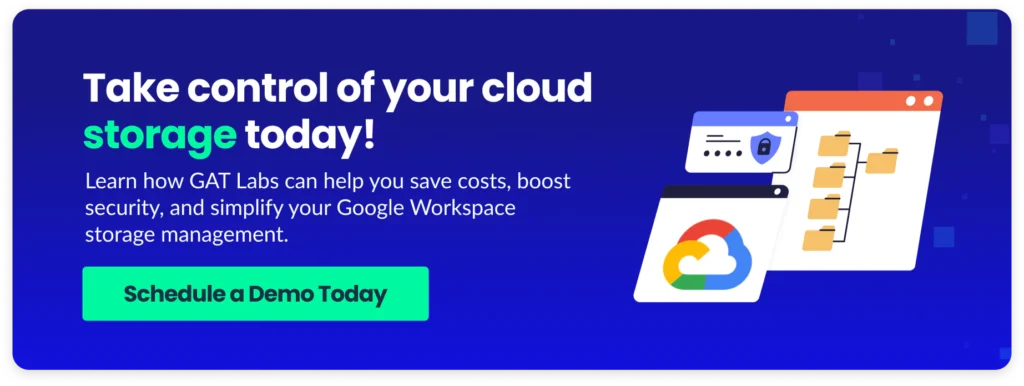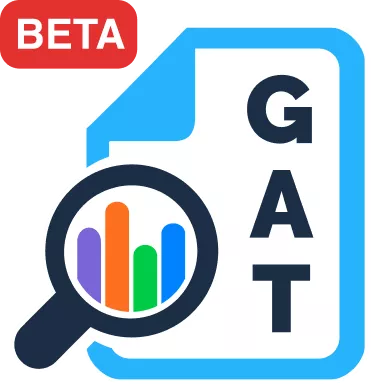Should you use Google Cloud Storage (GCS) as a Workspace Admin? It’s a question I hear often. While GCS is a powerful tool for scalable storage, moving data outside Google Workspace has implications for visibility, costs, and security.
This blog breaks down the pros, cons, and best strategies for using GCS as a Google Admin.
What Is Google Cloud Storage?
Google’s cloud storage (GCS) is a scalable and secure platform designed for storing unstructured data like images, video files, and documents. GCS operates independently from Google Workspace but is part of Google Cloud’s infrastructure.
Some of its core features include:
- ▪️Access Controls: Manage permissions to determine who can view or edit files.
- ▪️ Lifecycle Management: Automate the archiving or deletion of data based on predefined rules.
- ▪️ Data Monitoring: Gain detailed insights into storage usage patterns to optimise costs.
GCS is commonly used for external data storage and integration with other cloud tools, such as SIEM systems or custom dashboards in Looker. However, moving data to GCS comes with important considerations for Google Admins.
The Pros of Using GCS as a Google Admin
1. Cost Savings for Archiving Data
GCS offers lower costs compared to Archive User (AU) licenses for storing leavers’ data. This can be an economical solution for long-term archiving.
2. Flexible Data Integration
GCS can store GAT+ reports or other data for integration into SIEM systems or custom dashboards, enabling advanced analytics and reporting.
3. Scalability
GCS allows organisations to scale storage capacity quickly without the need for hardware investments.
The Cons of Moving Workspace Data to GCS
1. Loss of Visibility and Control
Once data is moved to GCS, admins lose access to revision history, sharing insights, and other metadata tied to Workspace. Managing permissions and tracking changes becomes more difficult.
2. Fragmentation
Splitting data across Workspace and GCS can create silos, making it harder for teams to collaborate effectively.
3. Additional Costs
While GCS may be cheaper than AU licenses, it still adds a new expense to the organisation. Keeping data within Workspace might eliminate these costs entirely.
4. Security Risks
Moving data outside of Workspace increases the risk of misconfigurations or unauthorised access if GCS permissions are not managed correctly. In fact the leading cause for cloud data breaches is due to misconfiguration!
When Does It Make Sense to Use GCS?
1. Archiving Leavers’ Data
GCS can be a cost-effective alternative for storing archives of leavers’ data, particularly for organisations looking to reduce reliance on Archive User licenses. By using lifecycle policies to manage data placement, organisations can save up to 25% on storage expenses.(Source: TechFunnel).
2. Integrating with External Systems
Exporting GAT+ reports to GCS allows organisations to feed data into SIEM systems or build custom dashboards for enhanced monitoring and analytics.
3. Storing Large, Unstructured Data
GCS is ideal for storing large volumes of data that do not require frequent access, such as backups or multimedia files.
Why Keeping Data in Google Workspace Is Often Better
1. Full Visibility
Workspace tools like GAT+ allow admins to monitor file usage, sharing activity, and access patterns in real-time, ensuring better control and compliance.
2. Seamless Collaboration
Keeping data within Google Workspace ensures teams can collaborate effectively without jumping between platforms.
3. Cost-Free Storage for Current Users
By optimising shared drives and cleaning up redundant data, admins can often avoid additional storage costs altogether.
4. Cost-Free Storage for Archive Users
Reduce your Archived User license cost whilst continuing to have all the benefits; searchable in Vault, retain revision history and file event history. Using GAT Flow you can manage your Archive User data and easily move data to Shared Drives or a centralized service account.

How GAT Labs Supports Google Workspace Admins
GAT Labs provides tools to help Google Admins manage Workspace storage efficiently without the need to move data to GCS:
- ✔️ Automated File Audits: Gain insights into file storage, sharing, and ownership.
- ✔️ Cost-Saving Opportunities: Identify and resolve redundant data usage to reduce overall storage costs.
- ✔️ Real-Time Monitoring: Track activity across your domain to maintain security.
- ✔️ Lifecycle Management: Automate policies to archive or delete files based on organisational needs.
While Google Cloud Storage is a powerful tool for scalable storage, it’s not always the best choice for Google Admins managing Workspace data. Understanding the trade-offs and leveraging tools like GAT+ to optimise Workspace storage can help your organisation save costs, maintain visibility, and simplify management.
Ready to learn more? Request a demo today and discover the difference it can make for your organisation.
FAQs
1. What is Google Cloud Storage?
Google Cloud Storage is a fully managed object storage service offered by Google Cloud. It is designed for storing and retrieving unstructured data like images, videos, and documents.
2. How does GCS relate to Google Workspace?
GCS operates independently from Google Workspace. While you can store exported reports from Workspace in GCS, tools like GAT+ manage data directly within Google Workspace.
3. When should I use GCS instead of Workspace storage?
GCS is ideal for archiving leavers’ data, integrating reports into SIEM systems, or storing large, unstructured datasets.
4. What are the key benefits of GAT Labs for Google admins?
GAT Labs provides detailed audits, real-time monitoring, and automation tools to streamline Google Workspace storage management.
5. How can I optimise costs in Google Workspace storage?
Identify redundant files, set lifecycle policies, and leverage tools like GAT+ to ensure efficient use of storage.
Insights That Matter. In Your Inbox.
Join our newsletter for practical tips on managing, securing, and getting the most out of Google Workspace, designed with Admins and IT teams in mind.







